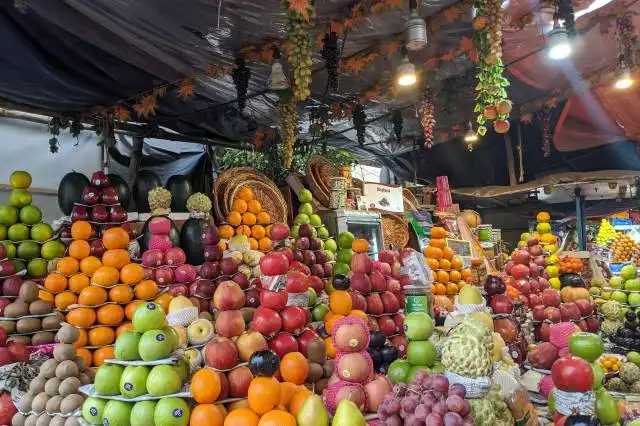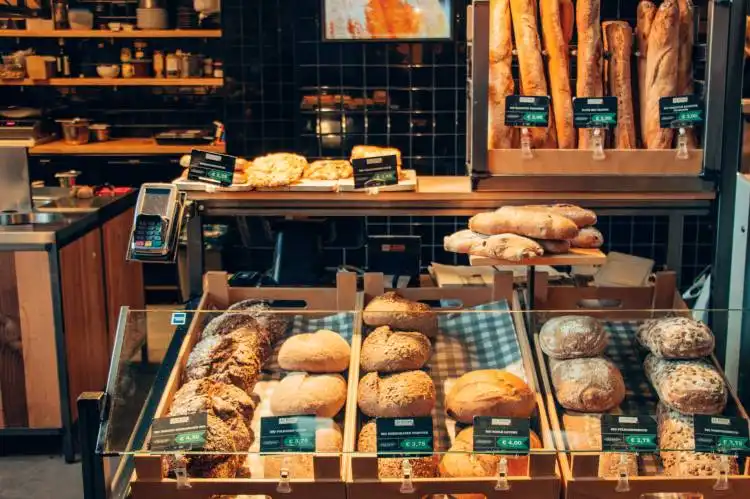Start a Food Staple Business
Concocting Success with a Food Staple Empire
| Updated


FOOD STAPLE BUSINESS
Get ready to dive into the heart of every kitchen with a Food Staple Business. This venture involves selling essential food commodities like rice, grains, canned goods, and much more. It's a delicious junction where necessity meets diversity. So why not shelf your brilliant entrepreneurial abilities in this endeavor, giving folks ingredients and tools to cook up their beloved dishes while you cook up a successful empire!
Jump to Business Plan
RELATED BUSINESS IDEAS
Browse ALL Food & Beverage Entrepreneurship Business Ideas
Discover Your Perfect Domain
Unlock the door to your online success with our hand-picked selection of premium domain names. Whether you're starting a new venture or rebranding an existing one, the right domain can set the tone for your digital presence. Browse through our curated list, each with its unique potential to enhance your brand's visibility and credibility.
FOOD STAPLE MINI BUSINESS PLAN
This a quick reality check to help you identify the strengths and weaknesses of your business concept before you dive in.
Business Idea: Food Staple Business
Expected Percent Margin:
- Gross Margin: 25-35%
- Net Profit Margin: 10-15%
Earnings Expectations:
- Daily Earnings: $150 - $350
- Weekly Earnings: $1,050 - $2,450
- Monthly Earnings: $4,500 - $10,500
- Annual Earnings: $54,000 - $126,000
Actions to Hit Those Numbers:
Product Sourcing:
- Initial Investment: Around $10,000 - $30,000 for diverse, quality food staple inventory.
- Supplier Network: Forge strong relationships with at least 3-5 dependable local or national suppliers.
Marketing and Customer Acquisition:
- Offline Advertising: Distribute flyers and coupons in the neighborhood to attract initial customers.
- Social Media: Maintain active profiles on suitable platforms to connect with customers and promote daily deals.
Sales and Customer Service:
- Staff: Hire and train 2-4 staff members to provide excellent customer service and manage day-to-day operations.
- Customer Retention: Implement a loyalty program or discount for frequent shoppers.
Cost Control:
- Rent: Choose a location where rent is less than 15% of projected monthly sales.
- Utilities and Maintenance: Keep aside around $300-500 per month.
Business Operations:
- Open Hours: Open at least 6 days a week, 8-12 hours a day.
- Products Sales: Aim for 50-100 transactions per day with an average sale price of $10-$15.
This is a broad-based estimate and can vary based on location, local economy, and individual business arrangements. It is always wise to seek consultation from a business financial advisor for personalized advice.
NOT WHAT YOU HAD IN MIND? Here are more ideas



Browse ALL Food & Beverage Entrepreneurship Business Ideas
Grab Your Business Website Name
Before you get caught up in the whirlwind of setting up your business, invest in a domain name. It's a small but significant step that lays the foundation for your brand and makes it easier for customers to find and trust you. Just like you wouldn't build a house without securing the land first, don't build a business without securing your domain name.
"Why? Can't that wait?" Here's why it shouldn't
Determine if the Business is Right for You
Breakdown of Startup Expenses
Before starting a food staple business, it is important to understand the startup costs associated with the venture. These costs can include the cost of renting a space, purchasing equipment, and obtaining necessary licenses and permits. Additionally, there may be costs associated with advertising and marketing the business. It is important to research these costs and create a budget to ensure the business is financially viable.
Breakdown of Ongoing Expenses
In addition to startup costs, it is important to understand the ongoing expenses associated with running a food staple business. These expenses can include the cost of ingredients, labor, and utilities. Additionally, there may be costs associated with maintaining the space, such as repairs and cleaning. It is important to understand these costs and create a budget to ensure the business is profitable.
Examples on Ways to Make Money
Once the startup and ongoing expenses are understood, it is important to understand how to make money with the business. This can include selling food items directly to customers, providing catering services, and selling products to other businesses. Additionally, the business may be able to generate additional income by hosting events or offering delivery services. It is important to research these options and determine which ones are right for the business.
Name the Business
Tips on How to Name the Business
Once the business is determined to be viable, it is important to choose a name for the business. When choosing a name, it is important to consider the type of food the business will serve, the target audience, and the overall mission of the business. Additionally, it is important to research the name to ensure it is not already in use. Once the name is chosen, it is important to register the business with the local government and obtain the necessary licenses and permits.
Benefits of Choosing a Unique Name
Choosing a unique name for the business can be beneficial in many ways. It can help the business stand out from the competition and make it easier for customers to remember. Additionally, it can help the business establish a brand identity and create a memorable experience for customers. It is important to choose a name that reflects the mission of the business and resonates with the target audience.
Step 1: Determine if the Business is Right Endeavor
Breakdown of Startup Expenses
Before starting a food staple business, it is important to understand the startup costs associated with the venture. These costs can include the cost of purchasing the necessary equipment, such as refrigerators, ovens, and other kitchen appliances. Additionally, the cost of purchasing ingredients, packaging materials, and other necessary supplies should be factored into the startup costs. Furthermore, the cost of renting a commercial kitchen space, if needed, should also be taken into consideration. Finally, the cost of obtaining any necessary permits or licenses should be included in the startup expenses.
Breakdown of Ongoing Expenses
Once the business is up and running, there are ongoing costs associated with running the business. These costs include the cost of purchasing ingredients and other supplies, as well as the cost of labor. Additionally, the cost of marketing and advertising should be taken into account. Furthermore, the cost of maintaining the equipment, such as refrigerators and ovens, should be factored into the ongoing expenses. Finally, the cost of insurance should also be taken into consideration.
Examples on Ways to Make Money
There are many ways to make money with a food staple business. One way is to sell the food staples directly to customers. This can be done through a website, a physical store, or a combination of both. Additionally, the business can partner with grocery stores and other retailers to sell their products. Furthermore, the business can offer catering services or meal delivery services. Finally, the business can also offer cooking classes or other educational services related to food staples.
Step 2: Name the Business
When naming a business, it is important to consider the message that the name conveys. The name should be memorable, easy to pronounce, and should reflect the type of business that is being started. It is also important to make sure that the name is not already taken by another business. Additionally, research should be done to make sure that the name is not offensive or inappropriate.
When coming up with a name, it is important to think about the type of business that is being started and the target audience. Consider the types of products or services that will be offered and the type of customers that the business will be targeting. Additionally, consider the values and mission of the business and how the name can reflect that.
When choosing a name, it is important to consider the potential for growth. The name should be able to grow with the business and should not be too specific to one product or service. Additionally, the name should be able to be used across multiple platforms, such as a website, social media, and business cards.
Finally, it is important to make sure that the name is legally available. Research should be done to make sure that the name is not already taken by another business. Additionally, it is important to make sure that the name is not offensive or inappropriate. Additionally, it is important to make sure that the name is not already trademarked or copyrighted.
Step 3: Obtain Licenses and Permits
Before starting a food staple business, it is important to obtain the necessary licenses and permits. Depending on the type of business, the licenses and permits required may vary. For example, a food staple business may need a food service license, a business license, and a health permit. It is important to research the specific requirements for the type of food staple business being started. Additionally, it is important to check with local and state governments to ensure that all necessary permits and licenses are acquired.
Cost of Licenses and Permits
The cost of licenses and permits for a food staple business can vary depending on the type of business, the location, and the size of the business. Generally, the cost of licenses and permits can range from a few hundred dollars to a few thousand dollars. It is important to research the cost of the necessary licenses and permits before starting a food staple business.
Where to Obtain Licenses and Permits
Licenses and permits for a food staple business can usually be obtained from the local government. Depending on the type of business, the licenses and permits may need to be obtained from the state government as well. Additionally, it is important to check with the local health department to ensure that all necessary permits and licenses are acquired.
Benefits of Obtaining Licenses and Permits
The benefits of obtaining the necessary licenses and permits for a food staple business are numerous. Having the proper licenses and permits in place can help to ensure that the business is operating legally and safely. Additionally, having the proper licenses and permits can help to protect the business from potential legal issues. Furthermore, having the proper licenses and permits can help to attract customers and build trust with the community.
Step 4: Secure Financing
Securing financing for a food staple business is an important step in the process. There are a few different options to consider when looking for financing. The first option is to seek out a loan from a bank or other financial institution. This can be a great option for those who have a good credit score and a solid business plan. Another option is to look for investors who are willing to provide capital in exchange for a stake in the business. This can be a great option for those who don’t have the credit score or collateral to secure a loan. Finally, entrepreneurs can look for grants or other forms of government funding to help get their business off the ground.
Step 5: Develop a Business Plan
Outline Goals
Developing a business plan is an important step in starting a food staple business. The business plan should outline the goals and objectives of the business, as well as the strategies and tactics to reach those goals. It should also include a financial plan, which outlines the expected costs and revenue of the business. Additionally, the business plan should include a marketing plan, which outlines the strategies to reach potential customers and build a successful brand. Finally, the business plan should include a risk management plan, which outlines the risks associated with the business and how to mitigate them.
Step 5: Create a Business Plan
Creating a business plan is an essential part of starting a food staple business. A business plan should include an executive summary, a market analysis, a description of the business, a description of the products and services, a description of the target market, a competitive analysis, a marketing plan, an operational plan, a financial plan, and an appendix. The executive summary should provide an overview of the business, the market analysis should provide an overview of the industry, the description of the business should provide an overview of the business’s goals and objectives, the description of the products and services should provide a detailed description of the products and services, the description of the target market should provide an overview of the target market, the competitive analysis should provide an overview of the competition, the marketing plan should provide a detailed plan for marketing the business, the operational plan should provide a detailed plan for the day-to-day operations of the business, the financial plan should provide a detailed plan for the financials of the business, and the appendix should provide any additional information needed to support the business plan.
Step 6: Register the Business
Registering the Business
Once the business plan is created, the business must be registered. This includes registering the business with the state, obtaining any necessary licenses and permits, and registering for taxes. Depending on the type of business, the business may need to register with the state as a corporation, limited liability company, or partnership. The business may also need to obtain a business license or permit from the state or local government. Additionally, the business must register for taxes with the IRS and the state. The business must also register for an Employer Identification Number (EIN) and any other required taxes.
Step 7: Open a Business Bank Account
Opening a Bank Account
Once the business is registered, the business must open a business bank account. This is important for tracking the business’s income and expenses. It is also important for separating the business’s finances from the owner’s personal finances. The business should open a business checking account and a business savings account. The business should also consider opening a business credit card account to help manage the business’s expenses. Additionally, the business should consider opening a merchant account to accept credit card payments.
Step 8: Market the Business
Marketing Strategies
Once the business is registered and the bank accounts are opened, the business must be marketed. This includes creating a website, setting up social media accounts, creating a mailing list, and advertising the business. The business should create a website to showcase the products and services and provide information about the business. The business should also set up social media accounts to reach potential customers. Additionally, the business should create a mailing list to keep customers informed about new products and services. Finally, the business should advertise the business through print, radio, television, and online advertising.
Step 9: Monitor and Adjust
Monitoring and Adjusting
Once the business is up and running, the business must be monitored and adjusted. This includes tracking the business’s income and expenses, monitoring customer feedback, and adjusting the business’s operations and marketing strategies. The business should track the business’s income and expenses to ensure that the business is profitable. The business should also monitor customer feedback to ensure that the business is meeting customer needs. Finally, the business should adjust the business’s operations and marketing strategies to ensure that the business is successful.
Step 6: Choose a Location
When selecting a location for a food staple business, there are several factors to consider. First, the location should be accessible to customers. It should also be in an area with a high population density, as this will increase the chances of attracting customers. Additionally, the location should be in an area with a good reputation, as this will help to build trust with customers. Furthermore, the location should be in a place that is convenient for employees to access, as this will help to ensure that the business runs smoothly.
Researching Local Regulations
Before selecting a location, it is important to research local regulations. This includes researching zoning laws, health codes, and other regulations that may apply to the business. Additionally, it is important to research the local competition and determine if the area is already saturated with similar businesses. This will help to ensure that the business is able to compete in the local market.
Securing a Lease
Once a location has been selected, it is important to secure a lease. This should include researching the terms of the lease, such as the length of the lease, the cost of the lease, and any restrictions or requirements that may be included in the lease. Additionally, it is important to research the landlord and ensure that they are trustworthy and reliable.
Securing Financing
In addition to securing a lease, it is important to secure financing for the business. This may include applying for a loan or seeking out investors. Additionally, it is important to research the different types of financing available and determine which option is best for the business. Finally, it is important to create a budget and ensure that the business is able to cover all of its expenses.
Step 7: Purchase Equipment
When starting a food staple business, there are certain pieces of equipment that are necessary for the business to run smoothly. This includes items such as a commercial refrigerator, a commercial stove, a food processor, and a deep fryer. Depending on the type of food staple business, additional equipment may be needed. For example, if the business is selling baked goods, then an oven and baking pans may be necessary. Additionally, a cash register, POS system, and other items may be necessary for the business to operate.
Where to Purchase Equipment
When purchasing equipment for a food staple business, it is important to research the best places to buy the necessary items. Many businesses purchase their equipment from local suppliers, as they may be able to offer better prices and more personalized service. Additionally, online retailers may offer better deals on certain items. It is important to compare prices and read reviews before making a purchase.
Financing Options
When starting a food staple business, it is important to consider financing options. Many businesses are able to secure loans or lines of credit to purchase the necessary equipment. Additionally, some businesses may be able to secure grants or other forms of funding. It is important to research all available financing options to determine which one is the best for the business.
Maintenance
Once the equipment is purchased, it is important to maintain it properly. This includes regularly cleaning and inspecting the equipment to ensure that it is in good working order. Additionally, it is important to keep up with any necessary repairs or replacements. This can help to ensure that the equipment is running properly and can help to extend the life of the equipment.
Step 8: Market the Business
When it comes to marketing a food staple business, there are several strategies that can be used to reach potential customers. Social media is a great way to reach a wide audience, as it is free and can be used to create engaging content. Additionally, word of mouth is a great way to spread the word about the business. It is important to reach out to local businesses and organizations to create partnerships that can help to increase visibility. Additionally, creating a website and utilizing search engine optimization (SEO) can help to increase visibility and reach a larger audience.
Advertising
Advertising is another great way to reach potential customers. Advertising can be done through various mediums, such as television, radio, print, and digital. It is important to create an advertising campaign that is tailored to the target audience and that resonates with them. Additionally, it is important to track the effectiveness of the campaign and adjust it accordingly.
Promotions
Promotions are a great way to get customers interested in the business. Offering discounts, free samples, and other incentives can help to draw in customers. Additionally, creating loyalty programs and offering rewards can help to keep customers coming back.
Events
Hosting events is a great way to get people interested in the business. Events can be used to showcase the business and its offerings. Additionally, events can be used to network and build relationships with potential customers.
Public Relations
Public relations is an important part of marketing a food staple business. It is important to create relationships with media outlets and influencers in order to get the word out about the business. Additionally, creating press releases and engaging in media interviews can help to increase visibility.
Step 9: Hire Employees
When it comes to hiring employees, it is important to take the time to find the right people for the job. Start by creating a job description that outlines the duties and responsibilities of the position. This will help to ensure that you are hiring the right person for the job. Additionally, it is important to conduct background checks and interviews to ensure that the person is a good fit for the job. Additionally, consider offering competitive wages and benefits to attract the best candidates. Finally, make sure to provide a safe and comfortable work environment for all employees.
Training Employees
Once you have hired the right employees, it is important to provide them with the necessary training. This should include a comprehensive overview of the business, its products and services, and the job duties and responsibilities. Additionally, provide employees with the necessary tools and resources to do their job effectively. It is also important to provide ongoing training and development opportunities to ensure that employees are up to date on the latest industry trends and best practices. Finally, make sure to provide feedback and recognition to employees to ensure that they feel valued and appreciated.
EXPLORE MORE CATEGORIES
Browse ALL Business Idea Categories
TAKE THE NEXT STEPS










